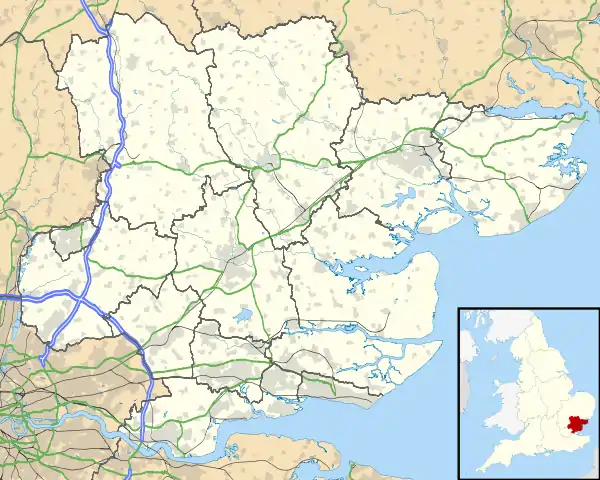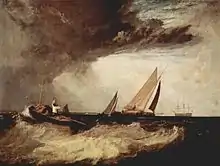Shoeburyness
Shoeburyness (/ˌʃuːbəriˈnɛs/; also called Shoebury) is a town in southeast Essex, England, at the mouth of the Thames Estuary. It is within the borough of Southend-on-Sea, situated at its far east, around 3 miles (5 km) east of Southend town centre. It was an urban district of Essex from 1894 to 1933, when it became part of the county borough of Southend-on-Sea.[2] It was once a garrison town and still acts as host to MoD Shoeburyness.
| Shoeburyness | |
|---|---|
 Shoebury East Beach | |
 Shoeburyness Location within Essex | |
| Population | 11,159 (2011 Census)[1] |
| OS grid reference | TQ941851 |
| Unitary authority | |
| Ceremonial county | |
| Region | |
| Country | England |
| Sovereign state | United Kingdom |
| Post town | Southend-on-Sea |
| Postcode district | SS3 |
| Dialling code | 01702 |
| Police | Essex |
| Fire | Essex |
| Ambulance | East of England |
| UK Parliament | |
Shoeburyness is divided into halves; Shoeburyness refers to all of the town, but North Shoebury refers to the area that houses Shoeburyness High School and the nearby churches.
Description
_girls_at_the_Royal_Artillery_Experimental_Unit%252C_at_Shoeburyness_in_Essex%252C_using_the_Window_Position_Finder_to_sight_shell_bursts_in_the_air_or_water%252C_1943._TR744.jpg.webp)
The eastern terminus of the London, Tilbury and Southend Railway (c2c line) is at Shoeburyness railway station, services run to London Fenchurch Street in the city of London. The eastern end of the A13 is at Shoeburyness. The MoD Shoeburyness site at Pig's Bay is situated nearby and the facility is run by the company QinetiQ.[3]
Shoeburyness has two beaches: East Beach and Shoebury Common Beach (also known as West Beach), both Blue Flag beaches.[4]
East Beach is a sandy/pebbly beach around a quarter of a mile long and is sandwiched between the Pig's Bay MoD site and the former Shoeburyness Artillery barracks. Access to the large gravel/grass pay-and-display car park is via Rampart Terrace. East Beach is the site of a defence boom, built in 1944, to prevent enemy shipping and submarines from accessing the River Thames.[5] This replaced an earlier, similar boom built 100 yards (91 m) east.
The majority of the boom was dismantled after the war, but around one mile still remains, stretching out into the Thames Estuary. East Beach benefits from a large grassy area immediately adjacent to the sands, which is suitable for informal sports and family fun. Nearby is the site of the Iron Age Danish Camp.
At the beginning of the Second World War, the depositing of a magnetic ground mine in the mud at the mouth of the Thames by the Luftwaffe was observed at Shoeburyness. Various sinkings of ships near the English coast in the preceding months were thought by many to be due to U-boat torpedoes, though the Admiralty suspected magnetic mines were being used.[6] The heroic recovery of an intact mine on 23 November 1939, by Lieutenant Commanders Ouvry and Lewis from HMS Vernon made it possible for the Navy to study it and devise countermeasures to neutralise it; among these were the degaussing cables installed in merchant ships in Allied and British fleets, and, of course, wooden minesweepers.[7]
Shoebury Common Beach is bounded to the east by the land formerly occupied by the Shoeburyness Artillery barracks and continues into Jubilee Beach. Shoebury Common Beach is the site of many beach huts located on both the promenade and the beach. A Coast Guard watch tower at the eastern end of the beach keeps watch over the sands and mudflats while listening out for distress calls over the radio. A cycle path skirts around the sea-front linking the East Beach to Shoebury Common Beach, and thence into Southend and a number of other towns, including Leigh-on-Sea.
In popular culture

The English painter J. M. W. Turner depicted the fishermen of Shoeburyness in his oil painting Shoeburyness Fishermen Hailing a Whitstable Hoy. The painting was exhibited in 1809, and was part of a series Turner made of the Thames estuary between 1808 and 1810. The painting has been in the collection of the National Gallery of Canada since 1939.[8][9]
In the fifth Temeraire novel Victory of Eagles, Shoeburyness is the setting of a fictitious climactic battle in which Wellesley and Nelson drive Napoleon out of England in early 1808.[10]
Shoeburyness is home to "the commuter", protagonist in the eponymous song and music video by Ceephax Acid Crew.[11]
Shoeburyness is mentioned in the Porridge episode "The Harder They Fall" (S2 E6), at approximately 6'10".[12]
Shoeburyness is one of the better-known entrants in Douglas Adams' and John Lloyd's spoof dictionary The Deeper Meaning of Liff. It is defined as "the vague feeling of uncomfortableness caused by sitting on a bus seat still warm from someone else's bottom".
Shoeburyness is referenced in the Billy Bragg song "A13 Trunk Road to the Sea" in the lyric "If you ever have to go to Shoeburyness Take the A road, the okay road that's the best. Go motorin' on the A13".
Climate
| Climate data for Shoeburyness, Essex 1981–2010 | |||||||||||||
|---|---|---|---|---|---|---|---|---|---|---|---|---|---|
| Month | Jan | Feb | Mar | Apr | May | Jun | Jul | Aug | Sep | Oct | Nov | Dec | Year |
| Average high °C (°F) | 7.5 (45.5) |
7.6 (45.7) |
10.3 (50.5) |
12.8 (55.0) |
16.0 (60.8) |
19.3 (66.7) |
22.0 (71.6) |
22.0 (71.6) |
19.1 (66.4) |
15.1 (59.2) |
10.7 (51.3) |
7.9 (46.2) |
14.2 (57.5) |
| Average low °C (°F) | 2.4 (36.3) |
1.9 (35.4) |
3.5 (38.3) |
5.1 (41.2) |
8.0 (46.4) |
10.9 (51.6) |
13.3 (55.9) |
13.4 (56.1) |
11.4 (52.5) |
8.7 (47.7) |
5.2 (41.4) |
2.9 (37.2) |
7.2 (45.0) |
| Average precipitation mm (inches) | 42.3 (1.67) |
32.1 (1.26) |
34.4 (1.35) |
38.0 (1.50) |
42.8 (1.69) |
41.0 (1.61) |
39.1 (1.54) |
44.5 (1.75) |
42.8 (1.69) |
59.9 (2.36) |
52.3 (2.06) |
45.8 (1.80) |
515 (20.28) |
| Average rainy days | 9.5 | 8.0 | 8.6 | 8.4 | 8.0 | 8.0 | 6.9 | 6.9 | 7.6 | 10.0 | 10.0 | 9.4 | 101.3 |
| Source: Met Office[13] | |||||||||||||
Notable people
- Tony Holland (18 January 1940 – 28 November 2007), BBC screenwriter
References
- "Southend Ward population 2011". Retrieved 21 September 2015.
- Shoeburyness UD Essex through time: Administrative history of Local Government District Archived 1 October 2007 at the Wayback Machine, visionofbritain.org.uk; accessed 18 November 2017.
- "MOD Shoeburyness". Qinetiq. Retrieved 12 March 2016.
- "Blue flags awarded to a dozen sunny Anglia beaches". ITV News. Retrieved 31 May 2017.
- Gordon, Dee (3 February 2014). The Secret History of Southend-on-Sea. History Press. p. 84. ISBN 9780750955454.
- Winston S. Churchill, The Second World War, vol. 1, The Gathering Storm (Boston: Houghton Mifflin, 1948), p. 505.
- Simpson, James (23 November 2014). "How Britain Beat Germany's Magnetic Sea Mines". War Is Boring. Retrieved 31 May 2017.
- Shoeburyness Fishermen Hailing a Whitstable Hoy, before 1809, National Gallery of Canada website; retrieved 18 June 2013.
- Shoeburyness Fisherman Hailing a Whitstable Hoy, tate.org.uk; retrieved 18 June 2013.
- "The Temeraire Reread: Victory of Eagles". Tor.com. 18 May 2016. Retrieved 31 May 2017.
- "The Commuter" by Ceephax Acid Crew (2010) on YouTube; accessed 18 November 2017.
- "Shoeburyness Climatic Averages 1981–2010". Met Office. Retrieved 23 December 2012.
External links
 Media related to Shoeburyness at Wikimedia Commons
Media related to Shoeburyness at Wikimedia Commons- . Encyclopædia Britannica. 24 (11th ed.). 1911.
- Southend-on-Sea Borough Council Official Website